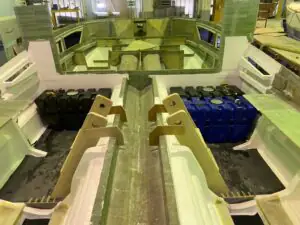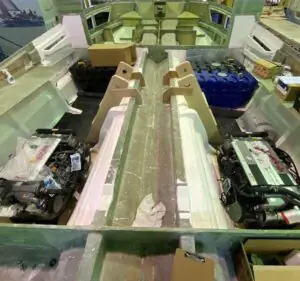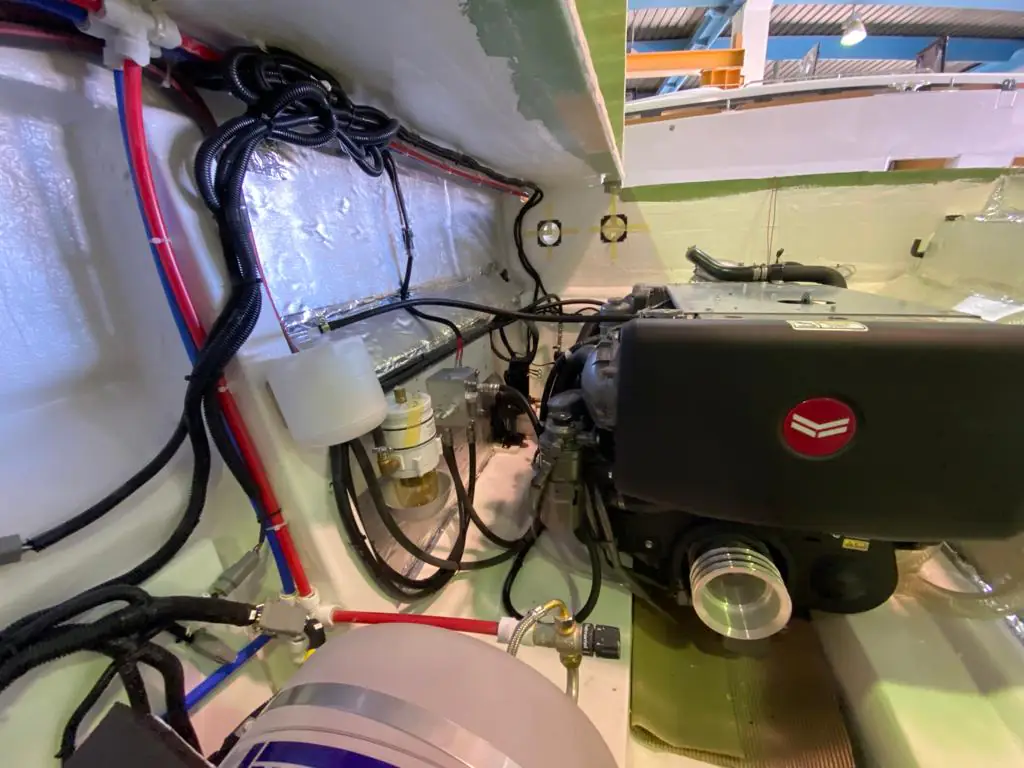Boat Build: Engines, Tanks, Plumbing and Equipment Installations
Detail-Oriented Craftsmanship
We consider ourselves exceptionally fortunate, thanks to our extensive experience in designing and constructing catamarans. Consequently, we possess an early understanding during the initial design phase regarding what to emphasize and incorporate into the design to achieve the best results, particularly during the construction phase. Frequently, we encounter boats that exhibit stunning style and craftsmanship but fall short when it comes to practical details. This is a mistake we were determined not to make. Our focus of the boat build extended deeply into the engine bay design to ensure that we created a space as practical and efficient as the M37 deserved.
Engine Installation
We disregard the fact that this is a functional space, firmly believing that as much effort and attention should be dedicated to the concealed elements as to those visible on the surface. It all commences with the engines; we possess remarkable potential in the two 370hp V8s we are installing, but that power must be harnessed effectively. It must transfer all the torque and horsepower through the substructure into the hull, converting it into forward momentum for the catamaran. Furthermore, it must accomplish this while transmitting minimal vibration and noise to the cockpit and cabins.

Strategic Placement to Reduce Noise
Before installing our tanks, we ensure that all areas of the engine room are painted white. While some builders might opt for a rough, unfinished approach, we believe that such an approach is inadequate for Makai. We have chosen white paint to create a bright, easily accessible, and workable space. Next, we begin installing our triple-layer sound deadening, which surpasses the standards typically used on vessels of this size. We line the primary bulkhead, the areas surrounding the engines, and the upper surface of the entire engine room, providing optimal soundproofing to the cockpit and cabins. We meticulously planned the placement of cabins, engines, and tanks early in our design process to maximize the separation between engines and sleeping quarters. Additionally, we’ve strategically positioned our tanks to create a liquid sound barrier between the engine and cabin space. Essentially, if you are sleeping, for instance, in the starboard hull, you have the bathroom, a sound-deadening barrier, fuel tank, and then a water tank between you and the engine. That’s a substantial number of baffles and barriers for sound to traverse.
Water Tank Installation
After installing the insulation in hard-to-reach areas, we lift our custom-made polyethylene rotomolded tanks into position and securely bolt them down. These tanks, with a capacity of 450 liters for fuel and 450 liters for water, are constructed from polyethylene to prevent corrosion and potential seam leaks. We designed them with thick walls to minimize distortion and effectively support the dynamic pressures generated by 450 kg of fluids sloshing about in rough conditions.

Innovative Molded Substructure
We underwent numerous iterations of structural engineering before ultimately settling on an innovative molded substructure. This substructure offers both stiffness and support where needed for the hull, as well as support and load transfer for the engines. We also integrated practical features such as flat floors for easy engine access and maintenance, mounting support for fuel and water tanks, and provisions for mounting electronics and hardware. Additionally, we incorporated underfoot bilges to keep your feet clean and dry while working around the engines. We also separated the engine sump from the surrounding areas to prevent oily bilge discharge that could harm native wildlife. All of these advancements were achieved through our vacuum-infused engine grid substructure. By vacuum-infusing these structures and securely bonding and glassing them into place, we achieve remarkable structural and practical improvements with minimal added weight.
With the engine grids firmly bonded in place and our powerful V8 Yanmar engines installed, our engine rooms are beginning to take shape. However, these engines won’t go far without fuel, and they won’t perform optimally without adequate airflow. That’s precisely what we’re currently working on.

Engine Room Ventillation
Finally, with engines, tanks, plumbing, and equipment all in place, we complete the engine bays by unveiling our molded-in inlet dorade. We’ve integrated this air intake into the window profile of the hull to maintain the vessel’s aesthetics. We’ve also ducted the hot air out at the stern, aided by four centrifugal blowers. This high-volume airflow ensures that the engine rooms remain well-ventilated and operate at optimal temperatures, which significantly impacts engine performance and fuel efficiency.
With our engine rooms now fully outfitted, the next milestone to watch for is the installation of our monocoque interior. Stay tuned for the upcoming update on our build series by regularly checking our stories page or subscribing to our mailing list for instant progress updates.
Read our first boat build story HERE
